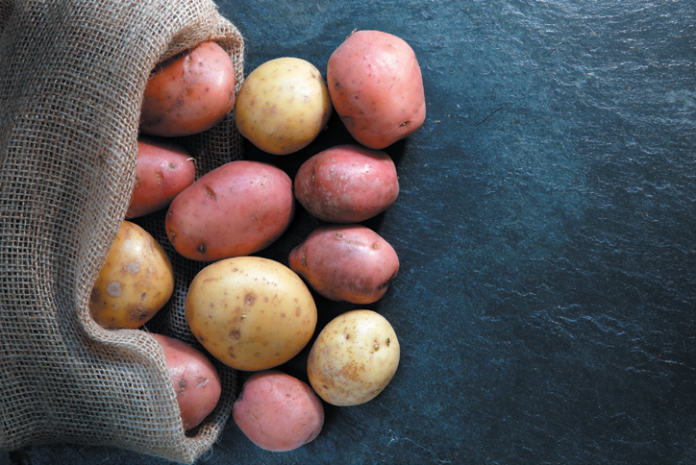If you are like most people in the U.S. (and the world), you eat a lot of potatoes. The average American eats over 100 pounds of potatoes a year—some baked, boiled, roasted, or mashed, but most in the form of fries and chips. Some shifts in how—and how often—we eat potatoes would be good for our health.
The Bad. White potatoes straddle the line between vegetable and starch. Their high carbohydrate content may spike blood sugar, potentially leading to overeating, weight gain, and increased risk of diabetes and cardiovascular disease. There is research to back up these concerns:
- In an observational study led by Dariush Mozaffarian, MD, DrPH, dean of the Friedman School and editor-in-chief of Tufts Health & Nutrition Letter, participants who increased their consumption of French fries over the 20-year study period gained an extra 3.4 pounds every four years. Those who increased intake of baked or mashed potatoes gained an extra 1.3 pounds.
- In another observational study, eating potatoes two to four times per week was associated with a seven percent higher risk for developing type 2 diabetes compared with eating them less than once a week. Eating seven servings a week was associated with a 33 percent increased risk. While all forms of potatoes—baked, boiled, fried and mashed—were linked to increased diabetes risk, French fries appeared most problematic. This higher risk with French fries may be direct, or indirect, with the fries serving as a marker for a generally unhealthy dietary pattern.
The Good. “Potatoes do have some positive nutritional attributes,” says Nicola McKeown, PhD, associate professor at the Friedman School and a scientist in the Nutritional Epidemiology Team at the Human Nutrition Research Center on Aging. One medium baked potato (skin on) can provide 30 percent of your vitamin C for the day and 25 percent of your potassium, plus a number of other vitamins and minerals. “Relative to other plant foods, potatoes do not rank as a high fiber food,” says McKeown. “Even so, a baked potato with the skin can supply 14 percent of your fiber for the day. Just keep in mind, though, you have to eat the skin to reap the fiber benefits.”
Potatoes are very high in a type of carbohydrate called resistant starch (RS). “This kind of starch promotes a greater feeling of fullness (satiety) and helps control blood sugar rise after a meal,” says McKeown. “While the type of resistant starch in raw potatoes is largely destroyed during the cooking process, chilling your potatoes after cooking, as you would for potato salad, increases the content of another form of resistant starch referred to as RS-3. This type of resistant starch acts as a prebiotic the feeds beneficial gut bacteria.”
Different types of potatoes have been found to raise blood sugar levels to varying degrees. Instant mashed potatoes and boiled red potatoes, for example, may raise blood sugar more than roasted white potatoes or baked Russet potatoes, according to research. Due to the resistant starch, cold or reheated potatoes have the least impact on blood sugar levels.
What to Do. The biggest problem with potatoes is how many we eat and what we eat with them. Potatoes are the most consumed vegetable in the United States, and potato chips top lists of popular snack foods. Another problem with potatoes is how we eat them: covered in salt or doused in saturated-fat-laden butter and sour cream, almost always without the fiber-rich skin. See the Take Charge! box for tips on making healthier choices.
Different varieties of potatoes have somewhat different nutrient profiles. Purple-, gold-, and red-fleshed potatoes have more phytochemicals than white, and sweet potatoes and yams are an excellent source of beta-carotene, which can be converted to vitamin A. But none of these tubers contain the same level of nutrients as non-starchy vegetables.
Be aware that some supposedly healthier potato choices may not live up to their billing. “Baked low-fat potato chips have none of the healthy vegetable oil used to make regular pototo chips—and all of the harmful starch and salt,” says Mozaffarian. “Regular potato chips are not a healthy snack compared to other choices like nuts, veggie sticks, fruits, yogurt, or cheese with whole-grain crackers, but at least they are fried in unsaturated-fat-rich vegetable oil.”
If potatoes are a regular part of your diet, try moving away from salty fries; hold the cream, sour cream, and butter; and reduce portion sizes. And move potatoes off the vegetable portion of your plate. “Potatoes are a starch and should be considered equivalent to eating pasta or rice,” says Mozaffarian. “Better yet, replace potatoes with non-starchy vegetables or whole grains.”
- Consider potatoes a starch, not a vegetable, and eat them in place of other starchy choices like pasta and rice.
- Avoid added salt and saturated fat. Cut potatoes into cubes, coat them in olive oil, and roast with herbs and spices like rosemary or paprika, and a little salt and pepper, or boil or microwave them whole. Keep the skin on and the condiments to a minimum.
- Eat potatoes cold or reheated to boost resistant starch content and consume them in a healthy meal. Both will help minimize spikes in blood sugar.
- Replace them. Consider a side salad or veggie instead of fries, nuts or fruit instead of chips, and roasted vegetables instead of baked potatoes.
























